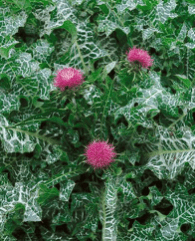Midsummer came and went, and the Wester Hailes Community Herbal Clinic has been busier than ever, seeing 30 patients in June. As part of our free community education programme we ran a summer herb walk in the Willow Garden in the Calders scheme. Some local residents who are interested in herbalism have started to grow some specific medicinal plants for community use in the Willow Garden and they have been coming along nicely. Two of the plants they have chosen to grow are Milk Thistle (Silybum marianum), and St John’s Wort (Hypericum perforatum), both of which we use frequently in the clinic.
Milk Thistle – Milk Thistle is a longstanding traditional European herb for supporting the function of the liver. It is an exampe of a plant whose old fashioned use has now been substantiated by modern clinical research. It has been found to actually help restore liver function where there is an injury to the liver or liver disease. It is so effective it can even help to reverse the effects of certain deadly poisons like the Avenging Angel mushroom (Amanita phalloides). We use it for patients with liver or gallbladder disease, and to support the liver where it has been damaged through substance use.
St John’s Wort – St John’s Wort is another very well known herb, and is one which has found recent acclaim as a natural anti-depressant. Although it can be effective at lifting the mood, this wasn’t its original traditional use. Historically St John’s Wort was used to support the nervous system and to heal wounds. It is useful as a pain reliever in neuralgia, sciatica, fibromyalgia and where pain is made worse through anxiety or tension. It can also be used externally as a valuable healing plant and anti-inflammatory where it can speed up the rate of wound healing. St John’s Wort can interact with some prescribed medications, so it is best to consult a herbalist before deciding to take this plant internally.


